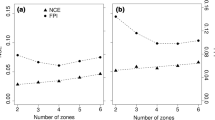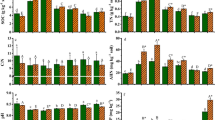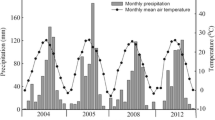Abstract
Site-specific nitrogen management has been proposed as a tool to increase crop yield while decreasing nutrient losses to the environment. Many reports can be found on sensing technologies to quantify the variability within a field and the definition of management zones based on the observed variability. However, fewer studies have been dedicated to the selection of the most suitable N fertilizer management scenario: should more or less nutrients be applied in the zones with a lower crop productivity potential? To address this knowledge gap, nine Flemish maize fields were selected as potential candidates for precision fertilization based on the soil maps and historical vegetation index patterns. Within each field, two management zones were identified based on historical vegetation index patterns and electrical conductivity maps, and different fertilization strategies were tested in each zone. The field trial results in terms of yield and soil residual nitrate showed that site-specific N management outperforms the conventional practice only in the fields with temporally stable management zones. In the fields having differences in the physical soil properties (e.g. presence of stones or clay particles), affecting water availability, lower fertilization in zones with a poor soil productivity potential could be recommended. In the fields where the performance of the management zones changes from year to year mainly due to annual variation in precipitation, a risk of incorrect implementation of the precision fertilization concept was identified. Historical NDVI time series serve a good basis to delineate the temporally stable management zones.









Similar content being viewed by others
Data availability
All data generated or analysed during this study are included in this published article.
References
Basso, B., Cammarano, D., Fiorentino, C., & Ritchie, J. (2013). Wheat yield response to spatially variable nitrogen fertilizer in Mediterranean environment. European Journal of Agronomy, 51, 65–70. https://doi.org/10.1016/j.eja.2013.06.007
Basso, B., Dumont, B., Cammarano, D., Pezzuolo, A., Marinello, F., & Sartori, L. (2016). Environmental and economic benefits of variable rate nitrogen fertilization in a nitrate vulnerable zone. Science of the Total Environment, 545–546, 227–235. https://doi.org/10.1016/j.scitotenv.2015.12.104Brock
Brock, A., Brouder, S. M., Blumhoff, B., & Hofmann, B. S. (2005). Defining yield-based management zones for corn-soybean rotations. Agronomy Journal, 97(4), 1115–1128. https://doi.org/10.2134/agronj2004.0220
Cambouris, A. N., Nolin, M. C., Zebarth, B. J., & Laverdière, M. R. (2006). Soil management zones delineated by electrical conductivity to characterize spatial and temporal variations in potato yield and in soil properties. American Journal of Potatoe Research, 83, 381–395. https://doi.org/10.1007/BF02872015
Casa, R., Pelosi, F., Pascucci, S., Fontana, F., Castaldi, F., Pignatti, S., & Pepe, M. (2017). Early stage variable rate nitrogen fertilization of silage maize driven by multi-temporal clustering of archive satellite data. Advances in Animal Biosciences, 8(2), 288–292. https://doi.org/10.1017/S2040470017000103
Databank ondergrond Vlanderen (Database subsurface Flanders) (n.d.). Digitale bodemkaart van het Vlaams Gewest: bodemtypes (Digital soil map of Flemish Region: soiltypes). Retrieved April 4, 2023, from https://www.dov.vlaanderen.be/portaal/?module=verkenner&do=doorprik&bm=27e3ac7e-2193-4714-8286-1b352457704a
Delgado, J. A., Khosla, R., Bausch, W. C., Westfall, D. G., & Inman, D. J. (2005). Nitrogen fertilizer management based on site-specific management zones reduces potential for nitrate leaching. Journal of Soil and Water Conservation, 60(6), 402–410.
Eurostat (n. d.). Agricultural census in Belgium. Retrieved April 4, 2023, from https://ec.europa.eu/eurostat/statistics-explained/index.php?title=Archive:Agricultural_census_in_Belgium#:~:text=The%20utilised%20agricultural%20area%20(UAA,44%25%20of%20the%20country's%20territory.
García-Martínez, H., Flores-Magdaleno, H., Ascencio-Hernández, R., Khalil-Gardezi, A., Tijerina-Chávez, L., & Mancilla-Villa, O. (2020). Corn grain yield estimation from vegetation indices, canopy cover, plant density, and a neural network using multispectral and rgb images acquired with unmanned aerial vehicles. Agriculture, 10, 277. https://doi.org/10.3390/agriculture10070277
Geypens, M., Vandendriessche, H., Bries, J., & Hendrickx, G. (1994). Experience with a nitrogen-index expert system: A powerful tool in nitrogen recommendation. Communications in Soil Science and Plant Analysis, 25, 1223–1238. https://doi.org/10.1080/00103629409369111
Green Deal targets for 2030 and Agricultural Production Studies (2022). Retrieved April 4, 2023 from https://agriculture.ec.europa.eu/system/files/2022-02/factsheet-farmtofork-comparison-table_en_0.pdf
Guerrero, A., & Mouazen, A. (2021). Evaluation of variable rate nitrogen fertilization scenarios in cereal crops from economic, environmental and technical perspective. Soil and Tillage Research, 213, 105110. https://doi.org/10.1016/j.still.2021.105110
Hong, N., Scharf, C. P., Davis, G., Kitchen, R. N., & Sudduth, K. A. (2007). Economically optimal nitrogen rate reduces soil residual nitrate. Journal of Environmental Quality, 36, 354–362. https://doi.org/10.2134/jeq2006.0173
International Organization for Standardization (1993). Soil quality – Determination of dry matter and water content on a mass basis — Gravimetric method (ISO Standard No 11465:1993). Retrieved from https://www.iso.org/standard/20886.html
International Organization for Standardization (2005). Soil quality – Determination of nitrate, nitrite and ammonium in field-moist soils by extraction with potassium chloride solution – Part 2: Automated method with segmented flow analysis (ISO Standard No 14256–2:2005). Retrieved from https://www.iso.org/standard/32399.html
International Organization for Standardization (2021). Soil, treated biowaste and sludge – Determination of pH (ISO Standard No 10390:2021). Retrieved from https://www.iso.org/standard/75243.html
Janssens, P., Garré, S., Reynaert, S., Dumont, G., von Hebel, C., Piccard, I., (2020). Variable rate irrigation and nitrogen fertilization in potato; engage the spatial variation (POTENTIAL). Heverlee: Soil Service Belgium. Retrieved April 4, 2023 from https://www.bdb.be/files/rap202001.pdf
Jovarauskas, D., Steponavičius, D., Kemzūraitė, A., Zinkevičius, R., & Venslauskas, K. (2021). Comparative analysis of the environmental impact of conventional and precision spring wheat fertilization under various meteorological conditions. Journal of Environmental Management, 296, 113150. https://doi.org/10.1016/j.jenvman.2021.113150
Kandulu, J., Thorburn, P., Biggs, J., & Verburg, K. (2018). Estimating economic and environmental trade-offs of managing nitrogen in Australian sugarcane systems taking agronomic risk into account. Journal of Environmental Management, 223, 264–274. https://doi.org/10.1016/J.JENVMAN.2018.06.023
Kizilgeci, F., Yildirim, M., Islam, M., Ratnasekera, D., Iqbal, M., & Sabagh, A. (2021). Normalized difference vegetation index and chlorophyll content for precision nitrogen management in durum wheat cultivars under semi-arid conditions. Sustainability (switzerland), 13(7), 3725. https://doi.org/10.3390/su13073725
Köninger, J., Lugato, E., Panagos, P., Kochupillai, M., Orgiazzi, A., & Briones, M. J. I. (2021). Manure management and soil biodiversity: Towards more sustainable food systems in the EU. Agricultural Systems, 194, 103251. https://doi.org/10.1016/J.AGSY.2021.103251
Li, Y., Shi, Z., & Li, F. (2007). Delineation of site-specific management zones based on temporal and spatial variability of soil electrical conductivity. Pedosphere, 17(2), 156–164. https://doi.org/10.1016/S1002-0160(07)60021-6
Li, W., Ma, L., Shi, F., Wang, S., Zhao, J., & Zheng, W. (2023). Regulation of soil water and nitrate by optimizing nitrogen fertilization and the addition of manure based on precipitation: An 8-year field record. Agriculture, Ecosystems & Environment, 354, 108586. https://doi.org/10.1016/j.agee.2023.108586
Matějková, Š, Kumhálová, J., & Lipavský, J. (2010). Evaluation of crop yield under different nitrogen dosesof mineral fertilization. Plant, Soil and Environment, 56(4), 163–167. https://doi.org/10.17221/196/2009-PSE
Milne, A. E., Webster, R., Ginsburg, D., & Kindred, D. (2012). Spatial multivariate classification of an arable field into compact management zones based on past crop yields. Computers and Electronics in Agriculture, 80, 17–30. https://doi.org/10.1016/j.compag.2011.10.007
Moral, F., Terrón, J., & Silva, J. (2010). Delineation of management zones using mobile measurements of soil apparent electrical conductivity and multivariate geostatistical techniques. Soil and Tillage Research, 106(2), 335–343. https://doi.org/10.1016/j.still.2009.12.002
Moshia, M., Khosla, R., Longchamps, L., Reich, R., Davis, J., & Westfall, D. (2014). Precision manure management across site-specific management zones: Grain yield and economic analysis. Agronomy Journal, 106(6), 2146–2156. https://doi.org/10.2134/agronj13.0400
Muschietti-Piana, M. P., Cipriotti, P. A., Urricariet, S., Peralta, N. R., & Niborski, M. (2018). Using site-specific nitrogen management in rainfed corn to reduce the risk of nitrate leaching. Agricultural Water Management, 199, 61–70. https://doi.org/10.1016/j.agwat.2017.12.002
Nawar, S., Corstanje, R., Halcro, G., Mulla, D., & Mouazen, A. M. (2017). Chapter four - delineation of soil management zones for variable-rate fertilization: A review. Advances in Agronomy, 143, 175–245. https://doi.org/10.1016/bs.agron.2017.01.003
Rimski-Korsakov, H., Rubio, G., & Lavado, R. S. (2009). Effect of water stress in maize crop production and nitrogen fertilizer fate. Journal of Plant Nutrition, 32(4), 565–578. https://doi.org/10.1080/01904160802714961
Roberts, D., Kitchen, N., Scharf, P., & Sudduth, K. (2010). Nitrogen management will variable-rate nitrogen fertilization using corn canopy reflectance sensing deliver environmental benefits? Agronomy Journal, 102, 85–95. https://doi.org/10.2134/agronj2009.0115
Robertson, M., Isbister, B., Maling, I., Oliver, Y., Wong, M., Adams, M., Bowden, B., & Tozer, P. (2007). Opportunities and constraints for managing within-field spatial variability in Western Australian grain production. Field Crops Research, 104(1–3), 60–67. https://doi.org/10.1016/j.fcr.2006.12.013
Roozbeh, M., & Rajaie, M. (2021). Effects of residue management and nitrogen fertilizer rates on accumulation of soil residual nitrate and wheat yield under no-tillage system in south-west of Iran. International Soil and Water Conservation Research, 9(1), 116–126. https://doi.org/10.1016/J.ISWCR.2020.09.007
Sela, S., Woodbury, P. B., & van Es, H. M. (2018). Dynamic model-based N management reduces surplus nitrogen and improves the environmental performance of corn production. Environmental Research Letters, 13(5), 054010. https://doi.org/10.1088/1748-9326/aab908
Stadler, A., Rudolph, S., Kupisch, M., Langensiepen, M., van der Kruk, J., & Ewert, F. (2015). Quantifying the effects of soil variability on crop growth using apparent soil electrical conductivity measurements. European Journal of Agronomy, 64, 8–20. https://doi.org/10.1016/j.eja.2014.12.004
Statbel (n.d.). Belgium in Figures. Final estimate of the production of agricultural crops – 2021. Retrieved April 4, 2023, from https://statbel.fgov.be/en/themes/agriculture-fishery/farm-and-horticultural-holdings#figures
Terrascope. Open-source satellite images (n.d.) Retrieved April 4, 2023, from https://viewer.terrascope.be/?language=nl&bbox=0.6363971976426429,50.14874007597746,6.50501380463302,51.769513810990276&overlay=false&bgLayer=MapBox&date=2019-02-25&layer=CGS_S2_RADIOMETRY
Vizzari, M., Santaga, F., & Benincasa, P. (2019). Sentinel 2-based nitrogen VRT fertilization in wheat: comparison between traditional and simple precision practices. Agronomy. https://doi.org/10.3390/agronomy9060278
Vlaamse Instelling Voor Technologisch Onderzoek (Flemish Institute for Technological Research) (2011). Anorganische analysemethoden: vaste stoffen. Totaal organisch koolstofgehalte (TOC). (Inorganic methods of analysis: solids. Total organic carbon content (TOC)). Retrieved April 4, 2023, from https://reflabos.vito.be/2011/CMA_2_II_A.7.pdf
Vlaamse Instelling Voor Technologisch Onderzoek (Flemish Institute for Technological Research) (2021a). Bemonsterings- en analysemethodes voor mest, bodem en veevoeder in het kader van het kader van het mestdecreet (Sampling and analysis methods for manure, soil and fodder in the context of the fertilizer decree). Retrieved September 2, 2023, from https://reflabos.vito.be/2021/BAM-deel1-04.pdf
Vlaamse Instelling Voor Technologisch Onderzoek (Flemish Institute for Technological Research) (2021b). Vloeibare mest en vloeibare behandelde mest -Totale stikstof. Bemonsterings- en analysemethodes voor mest, bodem en veevoeder in het kader van het mestdecreet (Liquid manure and liquid treated manure -Total nitrogen. Sampling and analysis methods for manure, soil and fodder in the context of the manure decree). Retrieved April 4, 2023, from https://reflabos.vito.be/2021/BAM-deel3-06.pdf
Vlaamse Land Maatschappij (Flemish Land Society) (2020). Normen en richtwaarden 2020 (Norms and guidelines). Retrieved April 4, 2023, from https://www.vlm.be/nl/themas/waterkwaliteit/Mestbank/bemesting/aanwenden-van-mest/bemestingsnormen/brochures-normen-en-richtwaarden/Paginas/default.aspx
Waterinfo. Forecasts and water levels. Measurements rainfall (n.d.). Retrieved April 4, 2023 from https://www.waterinfo.be/Meetreeksen/
Xing, H., Zhou, W., Wang, C., Li, L., Li, X., Cui, N., & al. (2021). Excessive nitrogen application under moderate soil water deficit decreases photosynthesis, respiration, carbon gain and water use efficiency of maize. Plant Physiology and Biochemistry, 166, 1065–1075. https://doi.org/10.1016/J.PLAPHY.2021.07.014
Zhang, J., Guerrero, A., & Mouazen, A. (2021). Map-based variable-rate manure application in wheat using a data fusion approach. Soil and Tillage Research, 207, 104846. https://doi.org/10.1016/j.still.2020.104846
Acknowledgements
This research was financially supported by Flanders Innovation & Entrepreneurship (VLAIO HBC.2018.2230).
Funding
Flanders Innovation & Entrepreneurship,VLAIO HBC.2018.2230
Author information
Authors and Affiliations
Corresponding author
Ethics declarations
Conflict of interest
The authors declare that they have no conflict of interest.
Additional information
Publisher's Note
Springer Nature remains neutral with regard to jurisdictional claims in published maps and institutional affiliations.
Rights and permissions
Springer Nature or its licensor (e.g. a society or other partner) holds exclusive rights to this article under a publishing agreement with the author(s) or other rightsholder(s); author self-archiving of the accepted manuscript version of this article is solely governed by the terms of such publishing agreement and applicable law.
About this article
Cite this article
Tsibart, A.S., Dillen, J., Elsen, A. et al. Potential to reduce the nitrate residue after harvest in maize fields without sacrificing yield through precision nitrogen management. Precision Agric 25, 940–962 (2024). https://doi.org/10.1007/s11119-023-10100-1
Accepted:
Published:
Issue Date:
DOI: https://doi.org/10.1007/s11119-023-10100-1




